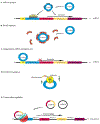Circular RNAs and gastrointestinal cancers: Epigenetic regulators with a prognostic and therapeutic role
- PMID: 31877535
- PMCID: PMC6982584
- DOI: 10.1016/j.critrevonc.2019.102854
Circular RNAs and gastrointestinal cancers: Epigenetic regulators with a prognostic and therapeutic role
Abstract
Both environmental and genetic factors are involved in the initiation and development of gastrointestinal cancer. Covalent closed circular RNAs (circRNAs) are produced by a mechanism called "back-splicing" from mRNAs. They are highly stable and show cell and tissue specific expression patterns. Although some functions such as "microRNA sponge" and "RNA binding protein sponge" have been reported for a small number of circRNAs, the function of thousands of other circRNAs is still unknown. Dysregulation of circRNAs has been reported in many GI cancers and are involved in metastasis and invasion. CircRNAs have been reported to be useful as prognostic markers and targets for developing new treatments. We first describe the properties and biogenesis of circRNAs. We then summarize recent reports about circRNA functions, expression status, and their potential to be used as biomarkers in GI cancers including, gastric cancer, colorectal cancer, esophageal cancer, hepatocellular carcinoma, gallbladder cancer and pancreatic cancer.
Keywords: Biomarkers; Circular RNAs; Gastrointestinal cancers; Prognostic indicator; Signaling pathways; microRNA sponge.
Copyright © 2019 Elsevier B.V. All rights reserved.
Conflict of interest statement
Declaration of Competing Interest MRH declares the following potential conflicts of interest.
Figures


References
-
- Akhter R, 2018. Circular RNA and Alzheimer’s Disease. Adv Exp Med Biol 1087, 239–243. - PubMed
-
- Álvarez-Chaver P, Rodríguez-Piñeiro AM, Rodríguez-Berrocal FJ, Martínez-Zorzano VS, de la Cadena MP, 2007. Identification of hydrophobic proteins as biomarker candidates for colorectal cancer. The international journal of biochemistry & cell biology 39(3), 529–540. - PubMed
-
- An Y, Cai H, Zhang Y, Liu S, Duan Y, Sun D, Chen X, He X, 2018. circZMYM2 Competed Endogenously with miR-335–5p to Regulate JMJD2C in Pancreatic Cancer. Cellular physiology and biochemistry : international journal of experimental cellular physiology, biochemistry, and pharmacology 51(5), 2224–2236. - PubMed
Publication types
MeSH terms
Substances
Grants and funding
LinkOut - more resources
Full Text Sources
Other Literature Sources

